
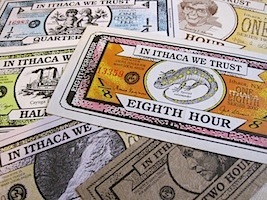



 |
 |
 |
 |
 |
| PAUL
GLOVER ESSAYS: community
control of food, fuel, housing, health care,
planning, education, finance. |
| HOME | INTRO | CURRENCY | SUCCESSES | HOW-TO BOOK | PUBLICITY | ESSAYS |
|
Ithaca Power Where Does Our Fuel Come From? written
and illustrated by Paul Glover, 1988,
winner of grant from the Fund for Investigative Journalism.
Here in Tompkins County these warm homes and speedy cars, the voices on television, the tapwater splash and refrigerator hum come to us by burning Chinese dinosaur soup, Groton cow manure, prehistoric Pennsylvania plant fumes, Mexican rotting beans, Colorado rock dust, Georgia cotton, and Louisiana rice shucks. All our tools and everything in stores come from these strange earthy fuels and other fuels gathered and burned, and they come to us from falling rivers and rain, from volcanos, wind and flames of sun. Our lamps are plugged into California and Canada, Brazil, South Africa, Norway, Nigeria, Italy, Algeria and Kuwait too.
Today greater Ithaca faces its greatest civic decisions, and Ithacans our greatest personal decisions because, though the fires are hotter now than ever, they're about to cool. Despite low oil prices the American joyride is ending. Cheap oil has allowed us, like children lured to cars by candy, to enter a danger zone, of dependence on foreign oil. Even more ominously, as this article will explain, major world and national energy agencies agree that world oil resources will soon begin sharp decline, that natural gas trails right behind, that nuclear power is increasingly dangerous, that we have been digging dirtier coal, that U.S. reserves of mined fuels are draining faster than new sources are found. This energy portrait of Tompkins County displays the power facts of our lives today, and describes choices and opportunities we face. All of us will live very differently, as Ithaca rebuilds to use reliable fuels, improving the ways we shelter, work, eat and move. The first half of the story describes today's standard fuel and the second half introduces local sources. THE LIGHT FANTASTICThis globe bristles with electricity, to 33,000 miles high, lashed by geomagnetic storms, lightning, northern lights. Our captured electricity is an electron chorus line kicking six billion billion electrons per second past every point on copper wire. Though science isn't agreed precisely what electric force is, electronics is a controllable miracle.
Local industries generated their own electricity with gasoline and coal, until NYSEG proved able to do so cheaper. The public hooked up eagerly, first for light, then to vacuum cleaners, refrigerators and radios, then to toasters, air conditioners, blankets, televisions and toothbrushes. These substitutes for gaslamp, icebox, quilt, broom and muscle presently cost Tompkins County nine million dollars per year. Ithacans of 1988 each use more than twice as much electricity as in 1960. NYSEG has become our Wizard of Oz, the monopoly utility whose machinery grants our wishes, on its own terms. Their price for electricity is just above the national average, but rises almost twice as fast as most consumer prices. Hell On Earth
When Milliken is shut for repair we take juice from
other NYSEG coal
plants, from the seven other New York state electric utilities, from
126
other electric utilities in the United States plus those of Canada.
Because NYSEG's 2,208 miles of power highway link us to 365,000 miles
of
lines nationally, the lights of Pyramid Mall and Cass Park can be lit
from
Tennessee rivers, from Utah uranium, Oklahoma natural gas, California
wind
or New Jersey garbage. New York State utilities swap power through the New York
Power Pool
switchboard near Albany. Although the network seldom fails, several
trends
are overloading it. Record high demand this summer (NYSEG 9 percent
higher) required more imports than usual. Central New York's electric
need
is expected to leap 50 percent in the next 14 years (NYPP Outlook 1988,
p.16) from the spread of homes, industries and businesses. At this rate
NYSEG would run short of steam within five years. And their 14 wheezy
coal
furnaces, average 31 years old, need more frequent repair. The state
itself foresees zero emergency capacity in about seven years and
constant
need for imported electricity seven years after that. None of the above are proper choices. There is good news
found in new
directions, more solutions than problems, but the nation, state and
county
have been drifting into dark holes. Next is a look at the largest:
coal.
|
|
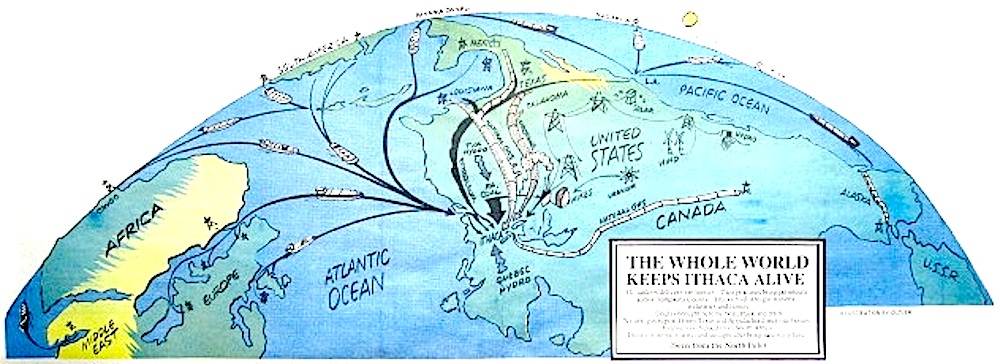 |
 Oil is black blood, as essential to life in Ithaca as the red blood inside us. Nearly all Ithaca's food is raised and hauled here by petroleum. Nearly all of us use gasoline to bring food home, to get to work and visit friends. Most of our clothes are wove of long oil molecules, like the plastics needed for telephones, electric transmission, appliances and tools. At least 24 percent of Tompkins County's homes are heated with fuel oil or propane. During the past 70 years the United States built tall cities and farmed half the continent, primarily with oil. America pumped itself to global power as the supreme oil producer and exporter. During the past 40 years, however, this country has needed increasingly to import foreign oil, 25 percent more since 1985, as it pours its strength into automobiles. New York state especially depends on oil imports, for 64 percent used. And most of it goes to gas tanks. Though the nation's first oil well spouted 180 miles southwest of Ithaca, our state produces only one of each 400 gallons it needs. From Tampico to You Tompkins County is transfused from the supertanker ports of Shanghai, Qatif, Minagish, El Harrach, Malaga, Genoa, Palembang, Rotterdam, Alwich, Cape Lopez, Pointe Noire, Tampico, Tuxpan, Lagunillas, La Salina, La Brea and again as many more. From these places the largest ships ever built bring millions of gallons of crude oil to refineries in the Virgin Islands, Bahamas, Texas, Louisiana, Los Angeles, New Jersey and Philadelphia. From the refineries come gasoline, diesel, fuel oil, propane and kerosene in other tankers or direct into underground pipes. The petroleum arteries crossing Tompkins County carry distillates from Mexico, Texas, Los Angeles, Louisiana and New Jersey. Pipeline fluids drool at 2.5 mph or gush, according to demand. The Texas Eastern Pipeline brings propane from the Gulf Coast near Houston through the Mississippi valley up the Appalachians and through Enfield, Newfield, Danby and Caroline on toward Albany. We tap this line at Watkins Glen and Harford Mills. 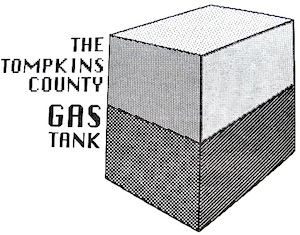 The
Colonial Pipeline, from Louisiana, serves the whole east coast and
delivers petroleum products to the Mobil, Atlantic, Sunoco and Buckeye
pipelines, which climb eastern Pennsylvania to our region. Mobil's line
receives oil up the Delaware River also, at the Paulsboro, New Jersey
refinery. It once fed our city directly with a branch to the West End.
We tap at Vestal and Elmira. Atlantic's products are refined in
Philadelphia and piped toward Rochester. The pipeline starts out 20
inches wide and narrows to 8 inches at Big Flats. Buckeye begins in
Linden, New Jersey and clips Groton on its way to both Buffalo and
Syracuse. Some of the petroleum barged up the Hudson into the Erie
Canal may reach us. The
Colonial Pipeline, from Louisiana, serves the whole east coast and
delivers petroleum products to the Mobil, Atlantic, Sunoco and Buckeye
pipelines, which climb eastern Pennsylvania to our region. Mobil's line
receives oil up the Delaware River also, at the Paulsboro, New Jersey
refinery. It once fed our city directly with a branch to the West End.
We tap at Vestal and Elmira. Atlantic's products are refined in
Philadelphia and piped toward Rochester. The pipeline starts out 20
inches wide and narrows to 8 inches at Big Flats. Buckeye begins in
Linden, New Jersey and clips Groton on its way to both Buffalo and
Syracuse. Some of the petroleum barged up the Hudson into the Erie
Canal may reach us.From these pitstops 9,200-gallon trucks deliver to gas stations, governments, industries, businesses and homes. PROPANE Bottled gas heats one of every 31 Tompkins County homes, runs tractors, forklifts, chicken incubators, hot water tanks, greenhouses and RV stoves. Though a major Tompkins County fuel, propane sales figures are trade secrets. Most we use is produced from Texas crude oil and in natural gas processing |
plants,
the rest flows from refineries. Most is brought by
bobtail truck (2,000-3,500 gallons) from Western Energy's deep salt
caves at Watkins Glen and Harford Mills. The remainder is trucked from
pipelines or railheads at Bath, Binghamton or Syracuse. Some even
arrives from Montreal and Chicago refineries. Tom Overbaugh of Ehrhart Propane in Trumansburg says there used to be some dozen dealers in Tompkins county but big operators bought small independents. Overbaugh is one of 8 county suppliers, and is chair of the New York State Liquid Gas Association's Education and Safety Committee. Propane must be handled with precision, being a gas which liquifies when pressurized and bums hot, to 3,595 degrees Fahrenheit, with nearly twice the heat per pound as coal. FUEL OIL Near the bottom of the refiner's barrel sits heavier goo, called #2, #4 or #6 oil for industrial and home furnaces, delivered in trucks like propane. About 8,000 homes in Tompkins County burn it. Since 1986 natural gas sales have declined as people switch to oil. The Last Drop Oil's offspring, gasoline mostly, have made North Americans the fastest most mechanized people in history. A voyage across Tompkins County that took many hours on Cayuga Indian trails needs 30 minutes now. Public sanitation is more reliable and backbreaking work more rare. Oil's several blessings, however, contain curses that threaten to shake civilization apart. One third of the Greenhouse Effect is believed caused by cars and trucks, each spouting their weight in carbon yearly. Millions of families are shredded by grief at 48,000 U.S. traffic deaths every year (12 in Tompkins County) and 140,000 permanent traffic injuries. Our coastlines and many rivers are suffocated by petroleum and its byproducts. But regardless whether we enjoy or endure oil, a large stop sign looms in our road. The United States is expected to run out of oil within thirty years, and the world will be world will be dry in forty years (U.S. Energy Atlas, The Energy Factbook, Beyond Oil, Introduction to Energy Technology, State of the World 1988). Much sooner the prices of gasoline, fuel oil, diesel will bring today's internal combustion machinery to a halt. The United States has used about 80 percent of its expected oil reserves. And the more we explore the less we find. The U.S. Geological Survey, after "disappointing drilling results," recently cut its estimate of onshore reserves by another 40 percent, to 33.4 billion barrels, or 7 percent of its 1972 estimate (Rochester Democrat & Chronicle 3/11/88). During the 1950s, fifty barrels of oil were found for each one spent drilling. Today that figure is five to one, and will fall to dead even as early as 1994. The United States imports more oil from the Middle East today than before the Arab oil embargo of 1973. After the next embargo those Arab nations, controlling 60 percent of the world's oil, would control the United States. Already gasoline costs $5.00 per gallon, when Persian Gulf military expense is added. Ten percent of U.S. industry is foreign-owned, thanks to national and trade deficits half due to oil imports. Twelve federal agencies combined to report that "growing oil import dependence places our national security at serious potential risk" (Los Angeles Times 3/18/87). Ithaca is not 'centrally isolated' from these global struggles. New York state is 75 percent more dependent on oil than the country in general. A desperate search is planned for domestic oil, to squeeze the last drops from tar sands at great cost: to sweat it from Rocky Mountain shale, polluting water and air, or to flush it under pressure. Professor Thomas Gold of Cornell believes plentiful oil may originate from meteoritic rock 100 miles below. Any such oil, if ever found, would be plenty expensive. Take a good look at Ithaca today with cars as we know them. They are soon to be antiques. Most of us in Tompkins County today will live to see the end of gasoline. The hunt for the future must continue elsewhere. |
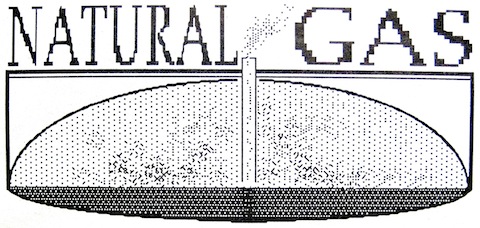 After the rock intestines of earth digest what erosion swallows, drilled wells tap the gas, filter and pump it through pipes to be burned for electricity, space heat and hot water. Much of it is made into fertilizer. The first gas produced here, in 1851 for street lamps, was from coal torched in the brick gashouse standing at Court and Plain Streets. News of gas discoveries in Central New York prompted Ithacans to dig also. The test bore of 1887, near the present Titus Towers senior housing, brought thousands of spectators. At 500 feet they struck bright bubbly mineral water "superior to Saratoga Springs water." Hundreds filled pails. Then a gas pocket spit fire ten feet high. At 2,400 feet the drill chewed salt till it quit at 3,150 feet. Yet there are natural gas fields in Tompkins County. Lansing, Groton and Danby drilled shallow wells in 1939 and 1940. A tin building atop a Lansing well "blew to pieces" years ago, and the Groton wells have been abandoned says Verl Rankin, a longtime resident. A few Danby wells are said to be producing for resident farmers. Four more deep empty wells were sunk in the early Sixties. Despite this dry history, Tompkins County is still a valuable prospect. Several major oil producers have bought oil and gas drilling rights in Tompkins County, based on seismic exploration by corporations which sell their charts for $1,100 per mile. Exxon, Sohio and Quaker State are among those which hold leases in Ulysses, Enfield and Newfield. When natural gas becomes scarce, they'll move in to find the 'tight' gas here, 2,500' deep. There is also "moderate" potential for shale gas, extracted by heating local rock to 350?F. How Much Gas is Left?The Potential Gas Committee's report of 1986 says we have a 30-year supply remaining. The Office of Technology Assessment (1985) expects short supply by the 1990s and insufficient supply by 2020. U.S. estimates of proven reserves have been cut in half during the past 20 years, despite record drilling activity between 1978 and 1985. Canadian gas will help in the short run, then decline as Canada's population increases. U.S. attempts to shake gas loose with nuclear explosions (1967-1973) did not work. Methane from coal seams might produce for a few years. Other sources such as high-pressure aquifers, low-permeable sands, permafrost, shale and polar seabed slush carry terrific expense. Western New York sandstones yield five percent of the state's natural gas. Although Auburn is a major nearby field, theirs goes northward. Beginning in the 1940s, interstate pipelines enabled Ithaca to import natural gas, now from as far as Los Angeles, Mexico and Canada. However, all of our natural gas is delivered to NYSEG by the pipelines of Consolidated Natural Gas, which is supplied mostly by the Tennessee Pipeline. Consolidated buys roughly half from Texas, Oklahoma, New Mexico, Louisiana, the Gulf Coast and half from Appalachia. NYSEG has longterm contracts, mainly with Louisiana suppliers, and shops monthly for cheaper gas from among over 1,000 suppliers to the 'spot market. |
The CNG pipelines (30-60 inches underground) feed gas to Tompkins County at six points: Newfield, Spencer Street in the city, Route 79 near German Cross Road, Freeville, Dryden and Groton. Pipeline gas pressure is reduced from 900 pounds per square inch maximum to 45 psi at the six NYSEG stations, to one- quarter psi entering homes, to one-eighth into stoves. Within the pipe grid gas changes direction with demand. Continued Lansing suburbanization would require a new pipeline across Groton. From the Ellis Hollow Creek Road compressor station in Dryden the gas enters 90 inches of pipeline (the most diameter in any New York town), to push toward Albany and Syracuse. These pipes are marvels of engineering which make life easy as long as there is gas to put into them. VILLAGE OF GROTON: The village is an exception to NYSEG
rule. The
people there pay one-third as much for electricity as the rest of us,
because they own and operate their own power lines. They primarily buy
cheap hydropower at $1.00 per kilowatt rather than NYSEG's nuclear at
$11.50/kw. |
| TRASH POWER Garbage burned produces electricity, just like coal, oil and natural gas do. That's why NYSEG, Cornell and Tompkins County each have proposed to use it for fuel. They claimed it would create energy (1,213kw/year) and reduce our landfill problem. Unfortunately though, it wastes more energy than it produces and makes a mess worse than landfill. Breathing, Drinking and Eating Old Sneakers Fly ash from over 75 waste-to-energy smokestacks in the United States, including 7 in New York state, puff carcinogens into the air: cadmium, lead, selenium, chromium, nickel, zinc, arsenic and mercury, plus over 200 organic chemicals and a gang of acid gases. The EPA has found its standards violated 40 percent of the time. West Germany reports monsterized fetuses downwind of its incinerators (Der Spiegel 9/10/84). Also dangerous is the solid ash. The same chemicals concentrated in ash are ready to wash into groundwater. They enter the food chain through water or air. Nor would we escape from landfills, since 25 to 40 percent of the original volume of trash remains as ash, to be disposed again. Burning trash destroys most of the energy in cans, bottles, newspapers and metals that would be saved by sending these materials directly back to factories instead. Recycling aluminum cans conserves 95 percent of the fuel needed to make them from ore. Recycling glass saves 13-35 percent, iron 90 percent and paper 23-70 percent. Plastic jugs can be recycled at Ithaca Scrap, saving 90 percent also. |
Unnatural Gas Tompkins County's old Caswell landfill in Groton, closed in 1985, lays decaying alone. Methane jumbled with carbon dioxide and nitrogen floats up from abandoned organics. Pipes vent the gas into the air, so that it doesn't trap and explode. If it were burned instead, 60,000,000 BTUs per day would be available for perhaps 20 years. Landstrom contains even more. Syracuse and Long Island recycle dumps this way. VOLCANO POWER The only geothermal power east of the Mississippi erupts 33 miles north in Auburn, to heat the gymnasium, racquetball courts and locker rooms of Cayuga Community College. Hot briny water (125-165?F) from a mile-deep well contributes to steaming of water for their electricity also. California's hot rocks contribute to the national electric system. The DOE National Forecast of 1982 asserts 10 percent of U.S. space heating could be brought from thermal strata. PEAT HEAT Waterlogged moss, animals and leaves sunk in swamps will become crumbly fuel after 5,000 years. They can be burned for electricity as in North Carolina, or used for rich potting soil. The U.S. has 190,000 square miles of it, mostly in Alaska. There are deposits in Groton's McLean Bog and elsewhere. Imported from Canada at $2.00 per cubic foot, peat would be expensive heat. If allowed to rest millions more years, peat would compress to brown coal, or lignite. More millions of years would produce hard black bituminous coal, then hardest anthracite coal, then oil then natural gas. |
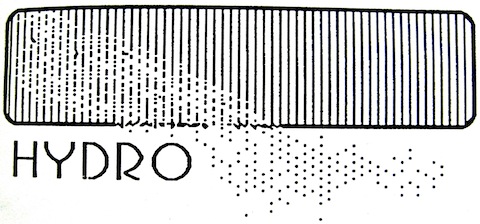 One
fifth of the world's electricity is produced by the raindrops that bend
grass, fill rivers and fall suddenly on metal rotors. The world's
biggest power plant, on the Parana River between Brazil and Paraguay,
generates with water more electricity than do 13 large nuclear power
plants. Norway and Zambia produce 99 percent of their electricity from
dams, Portugal 87 percent and South America 73 percent. Although the
United States generates more hydro power than any nation, this is only
four percent of our total use. West Germany and France also rely little
on hydropower. One may wonder which of the above are the advanced
nations, able serenely to enter the postnuclear, postpetroleum century. One
fifth of the world's electricity is produced by the raindrops that bend
grass, fill rivers and fall suddenly on metal rotors. The world's
biggest power plant, on the Parana River between Brazil and Paraguay,
generates with water more electricity than do 13 large nuclear power
plants. Norway and Zambia produce 99 percent of their electricity from
dams, Portugal 87 percent and South America 73 percent. Although the
United States generates more hydro power than any nation, this is only
four percent of our total use. West Germany and France also rely little
on hydropower. One may wonder which of the above are the advanced
nations, able serenely to enter the postnuclear, postpetroleum century.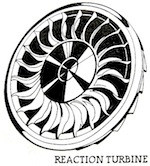 New
York State's native fuel is 88 percent hydro, yet is 23 percent of
total electricity generated here. The Great Wall of Niagara creates as
much electricity in 17 days as Tompkins County uses all year. The
state's Energy Research and Development Authority study of 1978 located
1,507 megawatts of abandoned hydropower statewide ready to be restored,
and 1,519 megawatts which would need dams. This total 3,026 megawatts
would be a tenth of total state generating capacity. New
York State's native fuel is 88 percent hydro, yet is 23 percent of
total electricity generated here. The Great Wall of Niagara creates as
much electricity in 17 days as Tompkins County uses all year. The
state's Energy Research and Development Authority study of 1978 located
1,507 megawatts of abandoned hydropower statewide ready to be restored,
and 1,519 megawatts which would need dams. This total 3,026 megawatts
would be a tenth of total state generating capacity.Greater Ithaca sparkles from flying water over monumental falls. These hills carved by water shape our lives. Just 210 years ago Cayuga Indians summer-camped in gorges for natural air conditioning, for fresh fish and cool drinks. Anglo settlers put the water to work grinding grain and sawing wood. As early as 1838 there were at least 74 waterwheels in Tompkins County, most on Taughhannock Creek and Fall Creek. Hydropower probably peaked about 1880. Cornell first made electricity from Beebe's dam in 1904, and has the only large hydro station in the area, producing about one percent of Cornell's power. Cornell water expert Steve Pacenko calculates that, were all the largest and smallest falls in the county harnessed to hydro and all the spaces between them terraced with dams for even more hydro, the theoretical hydroelectric capacity of Tompkins County would be 17 megawatts maximum, or 3 megawatts in drought years. |
Today the City of Ithaca is required by federal law to build a
hydroelectric station at Fall Creek Falls (using Ezra Cornell's 1830
tunnel), or to yield to Cornell University or one of the eight private
developers who would do so. Unless electricity from these falls is connected to equal electric conservation then their grandeur is sacrificed to America's energy waste. The City's plant would operate about 237 days per year, whenever more than 450 gallons per second falls. The 155 foot cascade, presently dry 128 days yearly, would become little more than a dribbling cliff for about 318 days. Only 47 days of the year would the falls be seen wetter than their new restricted flow (FERC Project #674, Revised Exhibits A, F, G: 1986). 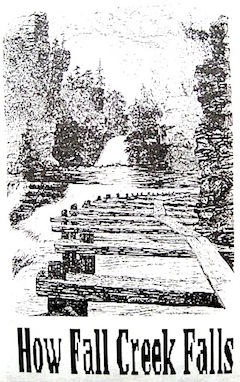 Therefore
many who approve hydropower as clean fuel prefer
installing
it at Six Mile Creek and elsewhere, instead. An attempt to free Ithaca
Falls from this fate was defeated by half of city council and the mayor
on June 8, 1988. If the measure is not successfully reintroduced, then
flows will fall. City voters were advised (illegally) to vote yes or
lose city control of the falls, though the city keeps its option until
1991. Therefore
many who approve hydropower as clean fuel prefer
installing
it at Six Mile Creek and elsewhere, instead. An attempt to free Ithaca
Falls from this fate was defeated by half of city council and the mayor
on June 8, 1988. If the measure is not successfully reintroduced, then
flows will fall. City voters were advised (illegally) to vote yes or
lose city control of the falls, though the city keeps its option until
1991.The city would be the least offensive operator, because there would be more direct control over flow, turbine noise and landscaping. Were the vote not rushed, the estimated $500,000 annual income from electric sales (after 15 years) could have been dedicated to weatherization and insulation as condition for approval. Ice Before refrigerators, ice from the lake around Stewart Park was an important fuel. Cut with ice plows dragged by horses wearing cleated shoes, frozen blocks were sledded to ice houses insulated with sawdust or hay. Farmers helped harvest each others' ponds, in barn-raising style. Most was distributed from ice wagons by 3 ice companies. Some went to New York City on the train. By 1904, Ithaca was actually importing ice from the Hygeia Ice Company of Elmira. Manufactured ice looked cleaner as lake pollution increased. The home refrigerator (1913) cracked the ice industry. Lake harvests continue in Miller's Mills, New York. |
 Even in
Tompkins County, New York, famous for cloudy seasons, the sun provides
87 percent of our winter heat by boosting the temperature up from 460
degrees below zero Fahrenheit (deep space) to zero degrees. Sunlight is
transparent flame that needs only a glass lens to cause fire, or an
afternoon for cooking sunbathers. Even in
Tompkins County, New York, famous for cloudy seasons, the sun provides
87 percent of our winter heat by boosting the temperature up from 460
degrees below zero Fahrenheit (deep space) to zero degrees. Sunlight is
transparent flame that needs only a glass lens to cause fire, or an
afternoon for cooking sunbathers.So intense is solar radiation that sun rays striking Egypt equal all civilization's energy. The National Academy of Sciences estimates the U.S. intermediate electric load could be sunpowered using an area 40 miles by 30 miles. Right here in Ithaca solar collectors are calculated able to fully warm homes between April and October, providing above 40 percent of our heat during the winter (CU Ag. Eng. Ext. Bulletin #421). The first local solar firm, Sunergy, encountered skepticism though, in 1977. Founder Elson Glover says, "local architects thought sun power for Ithaca was a joke." But solar experimentation expanded hereabouts and climaxed during the early Eighties when tax credits (up to $4,000) made risks appealing. Some projects failed from unsuitable design or neglect, while others are stiff doing well. The success stories prove the worth of this effort. On Meadow Street next to Purity Ice Cream the I.D. Booth warehouse produces nearly all its heat and hot water with 100 rooftop solar collectors. They carry sun's heat into a concrete floor. Manager John Kemery once operated a Pennsylvania solar business. "I know these machines work," he says, I've burned myself enough times to know." There are probably 50 homes using sun-baked water in Tompkins County, according to NYSEG's Tom Farrell. The utility gives loans for purchase of these units, as does Alternatives Federal Credit Union. Electric Sunlight Lynn and Becky McManus generate all their electricity with 16 square feet of Arco 47-watt solar electric (photovoltaic) panels, near Harford Mills. "Even on cloudy days we have to throw electricity away," says Becky, though they charge batteries, refrigerator, stereo and lights. A Spencer family's solar cells "work all year" for computer, TV, lights and radio, despite haze and an east-facing slope. They're buying more. Amanda Lott and Mark Shenstone of Trumansburg sun pump their water, lights and stereo. "We always have enough, never come close to low supply," says Amanda. She adds, "We feel strongly against nuclear power and centralized power in general, where a huge company controls a basic need at their own price." At $5.00 per installed watt photovoltaics are now competitive with nuclear power, their efficiency increasingly competes with/surpasses coal plants and they are the only electricity-generating device whose price is falling. Amorphous cells have achieved $2.00 per watt. Local electrical engineer Douglas Reid expects that mass production will swiftly put inexpensive solar panels on every house, like the VCR revolution. Professor Dieter Ast at Cornell also believes this inevitable. "The question is when. It is a matter of politics." He likes photovoltaics because they are simple-- made of purified sand-- have no moving parts, don't need water, reduce acid rain and dependence on the Middle East. The Solarex solar cell factory in Maryland is powered by its own product. Tom Farrell expects PV to take off during the next ten years: "People will sell solar electricity to NYSEG or store it at home." Solar motors, which focus sun up to 1,000 times, are being used by industry to manufacture tractors, brew beer and run radio stations. There are few solar furnaces in this region because focal collectors need direct rather than scattered light. Professor Jaroslav Vanek of Cornell has run a washing machine from a home-made collector. Electricity from the 10-story Solar One boiler near Barstow, California can be received here. |
Aggressively
Actively Passive As the ancients knew, homes can be designed as sun traps. Solar porches, south windows and attached greenhouses will produce free winter heat. Farrell believes several hundred area houses have solar features. This retrofit can be a major source of local construction jobs. 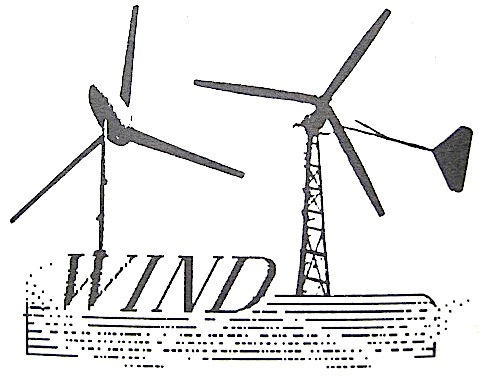 Air from the
globe's cold poles and hot spots, trying to trade places, gets swirled
into wind by the turn and tilt of Earth. Air from the
globe's cold poles and hot spots, trying to trade places, gets swirled
into wind by the turn and tilt of Earth.New York state is windiest beside Lake Ontario, up the Catskills and Adirondacks, out Long Island and on the east hills of each Finger Lake. NYS ERDA estimates 200-300 wind generators work statewide. Of these, over 100 windmills were added to the power pool between 1978 and 1986, when tax credits promoted small power. NYSEG buys electricity from 45 residential wind generators, mostly in Schuyler and Seneca counties. The United States produces 90 percent of the world's wind electricity, which is less than one percent of its own use. A National Research Council report of 1979 estimated wind could produce 15 percent of this country's energy by 2010. California's 16,769 wind turbines twirl one percent of their electricity, some of which may reach us. Once hundreds of hilltop windmills pumped water for Tompkins County farms. From 1898 to 1917 windmills were sold where Center Ithaca now stands. Today only a few rural towers remain. Sailboats are the foremost elegant use of moving air. Stiff breezes light several homes around Ithaca. For example, a Newfield family of four at elevation 1776 feet is independent of NYSEG. Their Jacobs'- style three-blade rotor on a 60-foot lower has been powering their vacuum cleaner, blender, computer, TV, stereo, lights, incubator, radio and electric fence for seven years. It starts packing 8 deep-cycle batteries when the wind hits 7 mph, and has to be turned off soon after. They have rarely run low. The average annual wind speed west of them on Connecticut Hill is 7.2 mph. Though the City's average is just 4.87 mph, reaching 6.92 in March, there exist practical windmills with 3 mph starting speeds. Elsewhere in Newfield, farmer-inventor Herman Cymara has patented a windmill (and 11 other things) which needs no tower. "Anyone could put it together inexpensively," says he. Professor Vaneck has also invented a model which sits low and scoops wind toward a paddlewheel. Over in Caroline a single blade rigged to a 38-foot tripod brightens lights, TV and stereo. There is a back windmill on a ten-foot tower along Route 79 in Dryden blurring its head off at only 1,100 feet. In that same town on Mount Pleasant, a resident reports wind strong enough half the year to make plywood and trashcans fly. But no windmills. While area winds are not steady enough for commercial wind farms, they are proving reliable for home dynamos. Extensive windmapping of Tompkins County by government and residents would get us ready to do it right. |
 Our oldest trees remember the Cayuga Indians. The first Europeans walked easily through forests of broad oaks and chestnut. One massive sentinel at the south end of Cornell's libe slope has seen the swamp below it made into a city, and the hill around it collegiated. Early settlers scalped most forest, to farm instead. By 1938 air photos show the county's woods reduced to hedgerows. The lapse of local agriculture has allowed 56 percent of Tompkins County to return to commercial forest. One quarter is maple. The Living Fuel The city's trees were once so large and dense that Ithaca was called the Forest City, until disease took the oaks, elms and chestnut. Still today approximately one third the city's area is shaded by leaves, according to city planner Jonathan Meigs. They are perhaps our most dignified and productive citizens. Without them, winter winds would penetrate our houses to chill our fuel bills and freeze our bank accounts. Summer heat would beat some 10 degrees hotter and, nationwide, the electric grid would faint away. The city's 5,500 street trees and 1,000 front yard trees also freshen the air which is fuel for our lungs. Thanks to abundant green, Central New York is one of the few inhabited regions storing more carbon dioxide than it releases. But suburbanization is destroying both forest and agriculture potentials as fertile topsoil is drowned in asphalt or squashed under lawn. This careless distribution of humans increases the energy load. Apple trees in Tompkins County drop 1.3 million pounds of fruit. Nuts and syrup are gathered. Field crop yields increase up to 35 percent with windbreak borders. As the Bough Breaks The Tompkins County woodpile stacks about 215 feet tall by 215 feet wide and long. The 1980 census counted 1,866 homes here heating with logs, burning an estimated 7,697 cords. Woodburning peaked in the early eighties after the 1979 oil crisis and has trimmed lately. More wood is used by many homes as backup fuel. Mike Leach of Ithaca Stove Works says that probably 15 to 20 percent of stove users here take wood from their own land. Most is delivered by five sawmills in Tompkins County (2,500 tons), by Cotton-Hanlon of Odessa (450-500 truckloads), by professionals like Shadow Arborists of Candor, Finger Lakes Firewood and Pierce of Groton, with the help of perhaps several dozen pickup truck woodcutters. Some get tired of loading wood, others thrive on it. Margaret Miller of Trumansburg, author of Tending the Fire says, "Its hard work, but I like feeling more independence and freedom. There's no monopoly on wood." Her chimney was cleaned last summer by a family of raccoons. On Elm Street, Sharon and Kirk Sapa spend $350 per year for heating. Their semi-underground barn-beamed sun-facing house, home also to blooming bougainvillas, fifty plants and flitting canaries, is designed for high energy efficiency. Their Sierra woodstove is shut off by February, to keep the space from getting "too hot." A greenhouse addition will further decrease need for fuel. Several sources suggest Tompkins County could heat entirely with its own wood. Richard Pancoe, South Central New York State DEC Forester, says that Cornell could, like Colgate University, depend on local wood. Although roughly 2-3 percent of this county's wood is harvested each year, it is believed total growth exceeds removal, despite the great loss of beech, ash and maple to disease. 55 percent of northern New England is wood heated. Hagerstown, Maryland (pop. 34,000) powers its central plant from a 500-acre municipal woodlot. Woodstoves produce only one thirteenth the sulphur and nitrous oxides coal burning does. The gritty bits released though, have caused bad air pollution in stovepipe communities. New EPA standards now limit catalytic woodstoves sold after July, 1988 to 7 cigarette-packs- per-day of particulates. Many stoves retailed locally already greatly improve on this requirement. Gas burn efficiencies are beyond 80 percent for some. Still, whether a third or all of us use wood we'd need to foresee the effect of this pyre on wildlife, erosion, noise, traffic, climate, greenspace and water. Gentler foresters will get 5 to 10 times more wood by coppicing: cutting trees back rather than down, speeding regrowth.  People are fertilizer factories. Flammable gas is made within us, like in the bowels of the earth. Taken by sewers to the Ithaca Area Waste Water Treatment Plant on Third Street, three million cubic feet of gas from 40,000 Ithacans bubbles from turd into tanks. It is set afire to warm and electrify the facility. The Chinese do this home-style: five million dwellings have biogas digesters for heating and lighting. In Groton, 350 dairy cattle contribute 2,100,000 pounds of manure per year to a concrete basement. The gas held under plastic fires an internal combustion engine which generates heat for Ron Space's farmhouse and electricity for the rest of us, via NYSEG. Since any plant or animal yields biogas when decomposing, power can be gotten from food crop leftovers like cornstalks and straw. Professor William Jewell, of Cornell's Agricultural Engineering Department calculates this residue, gathered within ten miles of Ithaca, could create all the natural gas the city's homes need. "We could reduce our consumption of foreign oil by three-quarters, decrease unemployment, improve the economic well-being of our farmers and promote a closer sense of community," he says. |
Jewell's
process for taking biogas from garbage before landfilling
would salvage about $1.6 million per year of electricity for Tompkins
County. This money would stay here to stimulate the local economy. His
greenhouse water purifier cleans Ithaca sewer water with plants that
consume pollutants. The system saves lots of money compared to
typical
sludge processing, and biogas can be taken from the plants for more
electricity. He has also invented a method to remove toxic metals from
sludge so it can be safely used by farms as fertilizer. This saves yet
more money. Jewell concludes that "the Ithaca area could be energy independent with a modest capital investment and without detriment to our environment."  Cars
drunk on corn liquor ride smoother. Grain ground and soaked,
fermented and distilled creates high-octane gasohol when added 1:9 to
gasoline. The 1986 Tompkins County corn crop could have produced
4,390,000 gallons of ethanol (at 2.5 gallons per bushel) plus 280,500
pounds of feed mash. Cars
drunk on corn liquor ride smoother. Grain ground and soaked,
fermented and distilled creates high-octane gasohol when added 1:9 to
gasoline. The 1986 Tompkins County corn crop could have produced
4,390,000 gallons of ethanol (at 2.5 gallons per bushel) plus 280,500
pounds of feed mash.Great plans for ethanol from corn must wait, to see whether the Midwest Breadbasket is being killed off by the Greenhouse Effect. This theory expects that the U.S. will become drier while the Sahara desert blooms again. In fact, Ethiopia reports its heaviest rains in 26 years and Sudan has its worst floods of the century (NYT 8/5 &14/88). Fortunately, 20 pounds of dead grass will yield a gallon of ethanol, too.  Liquid
hydrogen, made by electrocuting water, has been
used to propel automobiles and trucks. Its most famous jobs have been
the last Challenger spacecraft and the Hindenburg dirigible. Liquid
hydrogen, made by electrocuting water, has been
used to propel automobiles and trucks. Its most famous jobs have been
the last Challenger spacecraft and the Hindenburg dirigible.Benefits include clean exhaust and efficient thrust. However, its manufacture depends on other fuels. That's why Canada and Sweden produce it, from cheap hydropower. U.S. factories make it with natural gas, to be used for fabrication of fertilizer and petrochemicals. Some have suggested sending sunny Southland solar-generated hydrogen northward in natural gas pipelines.  Before fire or even clothes came food. Before crops came edible weeds and roots as nature offered them. Wild food expert Becca Harber says that about 25 percent of her own meals are foraged from nearby fields during April and May. "Most common plants are edible and/or medicinal. Few plants are poisonous." Suburbanites treat dandelions like communists, but they're highly nutritious. Lamb's quarters are fine in salad, day lilies are best stir-fried, nettles are tasty cooked, and so on nearly endlessly. Harber counts over 200 plants harvested for tea in Tompkins County. About 333,000 fish are taken from Cayuga Lake yearly. Almost half of them are smelt. Hundreds of deer are shot here during hunting season, and 300 run over yearly. Some are eaten. Cultivated Tastes The Tompkins County harvest of 1888 could feed us well today: 24 percent of the land popped up corn, wheat, oats, barley, rye and buckwheat; 31 percent went to pasture, orchard and vegetables; 23 percent made hay for 16,049 dairy cattle and 33,614 sheep. There were 9,175 pigs, 3,109 acres of potatoes and 108,403 chickens. Present-day machines and fertilizers would further increase the crop. However, large-scale mechanized agriculture is an energy loser. Vegetables need five calories of fossil fuel for every food caloric raised. Fruits need twice the fuel for each calorie of food, and meat needs ten to ninety times more. Eleven percent of U.S. fuel goes to food processing, packaging, transport, storage and cooking. Ithaca's increased local production would shorten these steps.  Food
Power converts to Muscle power. Among the jets, nukes and lasers, human
muscles do a minor but essential part of the nation's work. Tompkins
County's farm horses (9,819 in 1890) contribute little horsepower
today. They still help the Amish avoid high farm fuel costs. Food
Power converts to Muscle power. Among the jets, nukes and lasers, human
muscles do a minor but essential part of the nation's work. Tompkins
County's farm horses (9,819 in 1890) contribute little horsepower
today. They still help the Amish avoid high farm fuel costs.Most prominent of muscle machines is the bicycle. Local bike racer Glen Swan has ripped down East Miller Road at 65 mph and towed 187 pounds of brick out Cliff Street past the hospital. He once hauled two bikes on a trailer to the top of Buffalo Street. And, like several others, he rides all winter. Many of the rest of us ride bikes to conquer traffic jams, parking hassles, second car costs, pollution and flab. Ithaca College math instructor and concert pianist David Streater prefers his bike, owns no car. Potential U.S. bike utility is high, as 36 percent of commuters live within 3 miles of work, and half of all car trips are within the same short distance. 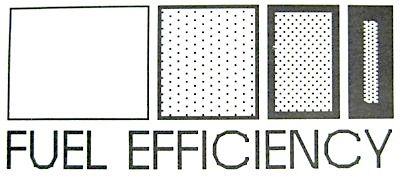 There's
no
fuel like less fuel. Any job done with less fuel liberates fuel for
other jobs and other generations. More clean fuel can be extracted from
fuel efficiency than any source. Modernization of the nation's
industrial motors would replace energy produced by 70 large nukes, and
switching to energy-efficient illumination would save the energy of 40
nukes, while new efficient household appliances will put 22 nukes to
rest. Independent power producers are expected to displace 12 nukes in
the next five years. New and retrofit superinsulated housing are
estimated able to reduce residential heating needs over 75 percent.
Every step in the direction of efficiency strengthens our future. There's
no
fuel like less fuel. Any job done with less fuel liberates fuel for
other jobs and other generations. More clean fuel can be extracted from
fuel efficiency than any source. Modernization of the nation's
industrial motors would replace energy produced by 70 large nukes, and
switching to energy-efficient illumination would save the energy of 40
nukes, while new efficient household appliances will put 22 nukes to
rest. Independent power producers are expected to displace 12 nukes in
the next five years. New and retrofit superinsulated housing are
estimated able to reduce residential heating needs over 75 percent.
Every step in the direction of efficiency strengthens our future.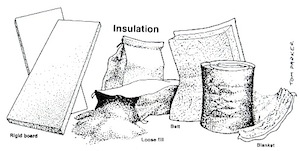 Efficiency
is the next shift of national gears. The continent's once-limitless
open spaces and cheap resources made growth a headlong race for wider
highways and taller buildings. But this style of 'progress" has led us
to decayed cities, hot Greenhouse summers, drug escape and crime, dying
forests, carcinogenic water, toxic garbage, the invasion of
foreign-controlled capital. Efficiency
is the next shift of national gears. The continent's once-limitless
open spaces and cheap resources made growth a headlong race for wider
highways and taller buildings. But this style of 'progress" has led us
to decayed cities, hot Greenhouse summers, drug escape and crime, dying
forests, carcinogenic water, toxic garbage, the invasion of
foreign-controlled capital.Consuming lots of oil and metal was long seen as essential to making big profits, but the opposite is now true. Greater Ithaca and a greater America will progress by consolidation: making what we've got already better. |
|
THE
FUTURE
Freeing
Enterprise
Efficiency will make this community busier than ever: we'll need far more jobs to prepare less need for fuel and to clean up past damage, than to blunder forward "growing." Saving even ten percent of the annual countywide NYSEG bill (87 percent of which leaves the county) would keep $7 million in the Ithaca area to be spent with each other instead, potentially to stimulate thousands of trades jobs, craft businesses, agricultural enterprises, daycare opportunities, revolving loan funds, community land trusts, wildlife sanctuaries, and further fuel efficiency. Minneapolis calculates $2.20 is added to their local economy for every energy dollar saved. Tightfisted fuel policy is essential for local prosperity, national security and world health. Worker-controlled fuel-efficient local enterprise could create goods and homes of better quality than Americans have ever had. If we do not retool and rebuild Ithaca's economy soon, while we still have cheap fuel, we will lose the luxury to change when the plug is pulled. The transition can be painless and profitable. Those who got rich from waste and suburbanization could be welcomed to use their talent (and wealth) instead to renew. Beginning at Home
Every one of us uses more fuel than we need for heating homes and water, more than is needed for lighting, cooking, refrigeration, transportation, packaging, entertainment and recreation. Some of us live at full throttle, using up America as fast as possible. Our cardboard homes spill heat through holes called windows. Our appliances obey the silliest whims, we're stuck to electric fun, our faucets run loose. Too noble for bikes, we would drive from kitchen to bedroom if possible. Others of us live modestly, pleased with friends and picnics, music, storytelling, a few books, fresh garden greens and a morning walk to work. But all of us have a lot more to learn. The simplest thing we can do is to look at ourselves in the energy mirror and plug one leaky habit this month. This means using appliances less or buying appliances that work better with less electricity. New national (1987) and state (1988) minimum efficiency standards will upgrade the tools which use 25 percent of U.S. electricity. Refrigerators using 1900 kwh will be replaced by units of 750 kwh or less. Same for freezers, window air conditioners, furnaces, water heaters, dishwashers, kitchen ranges and clothes dryers. NYSEG offers cash rebates to customers who buy efficient models. They are rewarding you for "negawatts:" the power plants they don't have to build because of the fuel you don't use. Some appliances can be improved instead of replaced. Up to 17 percent of Ithaca's residential heating bill can be saved simply by installing automatic thermostats that reduce heating while we're in bed. Water heaters can be insulated and temperature reduced. Automated furnace vents keep heat from pouring outside. Refrigerators located away from stoves and sun keep cool easier. NYSEG will also visit anyone's house free to analyse energy use and suggest money-saving improvements. Last year they did 3,644 residential energy audits. Most households took their advice. Superinsulation
By the year 2000 insulation is expected to be ten times cheaper than electricity. We have a lot of work to do: 97 percent of the City of Ithaca's homes were built before the 1973 energy crisis, with very little insulation. The 60 percent constructed before 1940 were not insulated. Five local companies have insulated a few thousand of these homes. Several homeowners, builders and INHS have superinsulated several old units, reducing heating costs by over 80 percent in some cases. They are heated mainly by body warmth, stoves and appliances, after the installation of triple-pane windows, and extra-thick insulation behind an airtight liner. They are ventilated deliberately rather than randomly. New York state's Energy Conservation Bank provides zero-interest loans for weatherization. NYSEG offers low- interest loans. EOC does it free for lowest income residents. A 1977 study (Masin and Klein) proposed an Ithaca insulation industry that would mix blown-in cellulose insulation from recycled newspapers with Milliken's fly ash as a fire retardant. Because most of the city's rental housing isn't insulated, the City Energy Commission drafted an ordinance (1986) requiring landlords to either insulate, double-glaze, or upgrade gas and oil heaters. The Building Commission estimates potential annual savings at $425,000. Big Jobs
Industry and business use about 50 percent of Tompkins County electricity. Much of it is wasted. Phil LaPadula of the state's Small Business Energy Efficiency Program (SBEEP) is one of 60 energy technicians showing merchants, farmers and non-profit organizations how to slim fuel bills. He saved one local retailer $850 per year, by replacing 30 night lights with four PL tubes costing $65. A restaurant saved $2,500 yearly in hot water by installing a $75 low-flow nozzle. Overall they have saved dozens of businesses hundreds of thousands of dollars. This suits NYSEG, which "would rather keep a customer than run them out of business or chase them away to a warmer climate," LaPadula says. Larger businesses can call on the Energy Advisory Service to Industry (EASI), for technical conservation studies. The state will pay up to $5,000 each for these. The Alternatives Federal Credit Union is the only local bank offering loans for this rehab, to the 46 eligible companies in Tompkins County. Tompkins-Cortland Community College has cut its energy consumption by half since 1980, by installing thermal glazing, and heating the rooms being used. NYSEG is required by law to spend 1.5 percent of its gross receipts on energy conservation ($2 million of $1.3 billion in 1987). Although they want to sell as much electricity as possible, they want to spread sales throughout the day, rather than overload the lines at noon. That's why they give a cheaper rate, like the telephone company, to businesses and homes which use service in late hours. Every Home a Power Company
Fuel costs and consumption can also be cut to a fraction, by cogenerators. Every major industry once had boilers which convert coal, oil, natural gas or propane into electricity plus useful heat and hot water. It's like the automobile drive shaft turning wheels while also running an electric radio and warming passengers. These machines come in all sizes. Cornell's new cogenerator takes useful power from 80 percent of the fuel it eats, compared to Milliken's 36 percent. Smaller businesses, like laundromats and donut shops can save thousands of dollars per year by buying refrigerator-sized generators. The investment is repaid in two to four years. Micro household units are sold. Some utilities are getting wise: New Jersey gas companies sell natural gas to cogenerators half price. The federal PURPA law of 1979 requires utilities to buy power from Ma and Pa Steamkettle-- anybody who wires their cogenerator, windmill, solar cells, waterfall, dump or cows to a NYSEG transformer. Even after planting cogenerators everywhere, welcoming renewable fuels, loading insulation and streamlining electrification with superconduction and magnetohydrodynarnics, America might still depend on dangerous fuels for metalworking and transportation. We would want to install the largest safety margin, to protect ourselves. For the long haul, Ithaca will be prudent to begin gradual changes in the structure of housing, transportation and food systems. Here, briefly, are a few examples. Each will need study and public planning. All entail great cultural change, but calm transition will meet the crisis ahead. Replacing the Automobile...
Widely believed needed for freedom and adulthood, the automobile drives into a ratrace trap. Replacing the 200 million U.S. gas hogs with 98-miles-per-gallon Toyotas only slow oil drain while crawling toward gridlock. American petroleum reserves will soon be, needed for more important things, like food production. There are ways to make the Ithaca area mobile without cars. ...with Trolleys
Between 1887 and 1935 the Ithaca Street Railway carried passengers from Cornell and Cayuga Heights to Stewart Park and the West End. It connected with interurban rails to Cortland, Syracuse, Elmira, Buffalo, New York City and the trolleys of 44 other New York state cities. |
Today over 40 U.S. cities are resurrecting their
trolleys. Fifteen states, including New York, are planning high- speed
commuter trains. The whole continent is crossed by Conrail lines.
Technical and financial analysis would show how we could join them. Trolleys would bring tourists with money, without cars, to see a better Ithaca, without polluting it. Student trolley routes would relieve East Hill traffic, boosting both downtown and collegetown shopping. The Ithaca- Cortland rail route reborn would save lives on Rte. 13, decrease commuter congestion and cost less than a new highway. Faster, safer, cheaper, more fun, necessary. ...with Safe Streets
Shortcut traffic can be kept from residential neighborhoods with planter barriers. Side streets can be converted to pocket parks, playgrounds, pathways and neighborhood orchards, retaining enough permeable stone for emergency and neighborhood access. These will inspire more people to walk to work. As Ithaca unpaves the way to a greener future, more rainwater will enter the ground, less will enter stormdrains, helping the lake cleanse. ...and with Bikeways
Well-kept crosstown bikeways separated from cars would allow Ithacans to shop, commute and visit without traffic hazard. The Ithaca Bikeway Study of 1975, defining exclusive bike routes, needs pumping again. There are more bikes than cars in flat Davis, California. Ithaca would offer ready-racks on buses and trolleys. Growing Food
The Drought of '88 may signal the end of reliable Midwest grain, due to Greenhouse climate change. One third our Breadbasket crop is lost. This coupled with world population increase means Ithaca will be responsible for growing more of its own food. To protect local farm potential we need stronger agricultural incentives, major tax abatements, land trusts and resolute zoning. Destruction of topsoil, by suburbanization and industrialization, should be prohibited. Property holding is the privilege to use land, not kill it. Tompkins County can't wait for the droughts of '89 or '90 to prove the need for local soil. The highest use of land will be to weave nature into the city: converting vacant lots to woodlots, orchards and community gardens. Ithakids could restore our urban ecology, planting edible street trees, learning planning. Cornell's intention to 'Siliconize' Ithaca, by contrast, threatens local agriculture and water quality. Cornell has hired David Costine of Silicon Valley to do here as he did to Princeton's Route One. Such industries have brought massive traffic tangles and poisoned groundwater, with high rates of cancer, birth defects and spontaneous abortions among workers. Cornell will insist their plan is safe, but Ithaca will be either aggressively safe or very sorry. Building Permanent Homes
Earth-sheltered housing needs no fuel for air conditioning and a trifle for heating. Five feet underground Ithaca's temperature stays near 54 degrees even mid-winter. Beautiful well-lit dwellings tucked into hillsides ought gradually to replace present structures, where possible. Thousands of U.S. homes are below ground, millions are earth-bermed. Ten million Chinese near Beijing stroll or garden their rooftops; courtyards give them lots of natural light. New Swedish subterranean office buildings are heated by human warmth and lightbulbs. Shopping malls in Montreal and industrial parks in Kansas sit underground. The largest such local building is Cornell's campus store. Building manager Kurt Howe says they have fine heat savings despite constant door opening and closing, and few problems with seepage in I I years of use. Ecolonies
Multiple-family structures are more energy-efficient because they share heat through walls. They are neighborhoods as well as housing, when shared areas are built-in. The ecolony, or ecological colony, is a semi-underground south- facing solar co-op community house. It provides well-soundproofed private spaces for those living alone or as couples, in nuclear families and neofamily groups. There are common areas for child care, health care, parties, meetings, dances, lounges, food production and processing, arts and exhibits, libraries and learning, theatre, worship and meditation, and cottage industry. They are designed by prospective residents. Limited-equity deeds keep rental and ownership costs low. PAYING FOR THE FUTURE
In addition to enriching Ithaca with fuel efficiencies, local wealth is created whenever we buy regionally-made food, furniture, clothing, etc. from locally-owned businesses. Similarly, money invested in democratic banks like Alternatives FCU (every investor has one vote) promotes capitalization of locally-controlled projects. Neighborhoods elsewhere (in Chicago, NYC, Philadelphia) have started their own banks. There are funds, like the Industrial Cooperative Association and Affirmative Investments, which help workers buy and convert businesses, with lawyers to show them how. There is federal and state seed money for new small enterprises. Ithaca should quit courting and subsidizing non- union and non-local industries. As well, Ithaca needs an Alumni Association, to obtain tax-deductible donations from the Cornell and Ithaca College alumni who enjoyed Ithaca, who liked their university more as alma mater than as factory. Many would find more satisfaction donating to trolleys and solarization than to monoliths. We would celebrate benefactors with speeches and plaques. Those afraid of Russia's military rarely notice the Soviets have an even stronger peace machine. They are more durable: they have twice our oil supply, twice our coal reserves and three times our natural gas. Most of their strategic metals are domestic, most of ours imported. They also use these more careful. Most of their transportation is by rail, which is 14 times more efficient than trucking and car travel. They manufacture fewer consumer baubles that waste energy and fill dumps. America's tough militarists guard our porch with guns ready while the house bums: our rate of oil use is making us a weak nation. And U.S. patriots who would condemn burning the flag eagerly burn the country itself, in cars. We Americans are the enemy inside, throwing America away, into wastebaskets. National security begins by marketing quality recyclable goods and developing our rail network. It rises with the nation's communities creatively changing together. Full national security arrives with global accord. Public Planners of Ithaca collects money to research prospects like these. Our city can teach the world by setting examples for the thousands of leaders who graduate from Ithaca's schools. Tompkins County needs to demand Federal spending priorities which defend the nation by rebuilding it. Contractor Peter Penniman estimates 6,700 Ithaca homes could be insulated for the price of one nuclear bomb, about $10,000,000. The state, likewise, should be more willing to spend $35,000,000 on an Ithaca area rail system than on another Route 96. Prepare for the Best These are some of many fuel choices and opportunities before us. There are endless good possibilities to be planned, financed and started. The best planning draws creative ideas from workers and residents. The worst sells neighborhoods. Typical progress rolls toward gridlocked cities, wall-to-wall walls, dead trees and air, rents too high for laborers, dangerous lonely streets. And energy poverty. Beyond bleeding-heart liberalism and heart-breaking conservatism, beyond plundering capitalism and bureaucratic socialism there is greener progress that strides toward full mutual employment, success and stability, natural beauty, national security and global sanity. And a powerful Ithaca with more fuel than it needs, produced in our back yard. Comments Paul Glover is also author of the "Amazing Ithaca History Calendar" (1976), "Los Angeles: A History of the Future" (1982), "Where Does Ithaca's Food Come From?" (1987), publisher of HOUR Town local currency news, and dozens of other articles and monographs. He holds a degree in City Management, rides his bicycle everywhere, and in 1978 walked across the U.S. entirely on foot. |
| HOME | INTRO | CURRENCY | SUCCESSES | HOW-TO BOOK | PUBLICITY | ESSAYS |